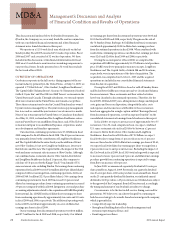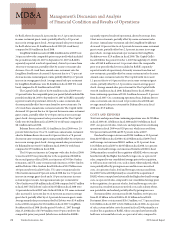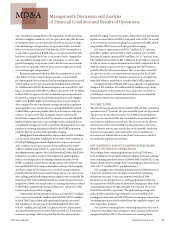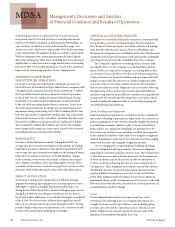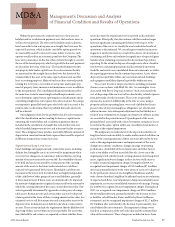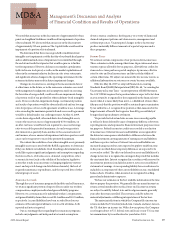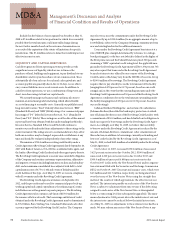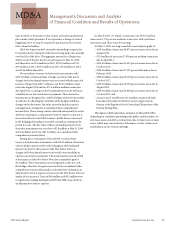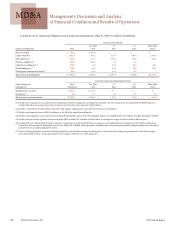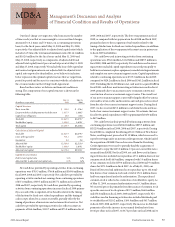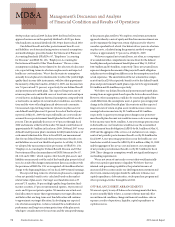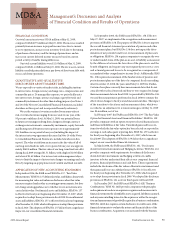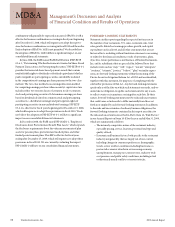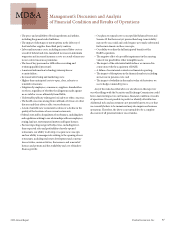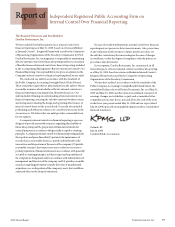Red Lobster 2009 Annual Report Download - page 31
Download and view the complete annual report
Please find page 31 of the 2009 Red Lobster annual report below. You can navigate through the pages in the report by either clicking on the pages listed below, or by using the keyword search tool below to find specific information within the annual report.
MD&A Management’s Discussion and Analysis
of Financial Condition and Results of Operations
2009 Annual Report Darden Restaurants, Inc. 29
We noted that an increase in the discount rate of approximately 10 basis
points on LongHorn Steakhouse would result in impairment of a portion
of its trademark. We also noted that an increase in the discount rate
of approximately 25 basis points on The Capital Grille would result in
impairment of a portion of its trademark.
We determined that there was no goodwill or indefinite-lived
intangible asset impairment as of the first day of our fourth fiscal quarter
and no additional indicators of impairment were identified through
the end of our fourth fiscal quarter that would require us to further
test for impairment. However, declines in our market capitalization
(reflected in our stock price) as well as in the market capitalization of
others in the restaurant industry, declines in sales at our restaurants,
and significant adverse changes in the operating environment for the
restaurant industry may result in future impairment charges.
Changes in circumstances, existing at the measurement date or
at other times in the future, or in the numerous estimates associated
with management’s judgments and assumptions made in assessing
the fair value of our goodwill, could result in an impairment charge
of a portion or all of our goodwill or other indefinite-lived intangible
assets. If we recorded an impairment charge, our financial position
and results of operations would be adversely affected and our leverage
ratio for purposes of our credit agreement would increase. A leverage
ratio exceeding the maximum permitted under our credit agreement
would be a default under our credit agreement. At May 31, 2009,
a write down of goodwill, other indefinite-lived intangible assets,
or any other assets in excess of approximately $750.0 million, on
an after-tax basis, would have been required to cause our leverage
ratio to exceed the permitted maximum. As our leverage ratio is
determined on a quarterly basis and due to the seasonal nature of
our business, a lesser amount of impairment in future quarters could
cause our leverage ratio to exceed the permitted maximum.
We evaluate the useful lives of our other intangible assets, primarily
intangible assets associated with the RARE acquisition, to determine
if they are definite or indefinite-lived. Reaching a determination on
useful life requires significant judgments and assumptions regarding
the future effects of obsolescence, demand, competition, other
economic factors (such as the stability of the industry, legislative
action that results in an uncertain or changing regulatory environ-
ment, and expected changes in distribution channels), the level of
required maintenance expenditures, and the expected lives of other
related groups of assets.
Insurance Accruals
Through the use of insurance program deductibles and self-insurance,
we retain a significant portion of expected losses under our workers’
compensation, employee medical and general liability programs.
However, we carry insurance for individual workers’ compensation
and general liability claims that exceed $0.5 million and $0.25 million,
respectively. Accrued liabilities have been recorded based on our
estimates of the anticipated ultimate costs to settle all claims, both
reported and not yet reported.
Our accounting policies regarding these insurance programs
include our judgments and independent actuarial assumptions
about economic conditions, the frequency or severity of claims and
claim development patterns and claim reserve, management and
settlement practices. Unanticipated changes in these factors may
produce materially different amounts of reported expense under
these programs.
Income Taxes
We estimate certain components of our provision for income taxes.
These estimates include, among other items, depreciation and amor-
tization expense allowable for tax purposes, allowable tax credits for
items such as taxes paid on reported employee tip income, effective
rates for state and local income taxes and the tax deductibility of
certain other items. We adjust our annual effective income tax rate as
additional information on outcomes or events becomes available.
Effective May 28, 2007 we adopted Financial Accounting
Standards Board (FASB) Interpretation (FIN) No. 48, “Accounting for
Uncertainty in Income Taxes – an interpretation of FASB Statement
No. 109.” FIN 48 requires that a position taken or expected to be taken
in a tax return be recognized (or derecognized) in the financial state-
ments when it is more likely than not (i.e., a likelihood of more than
fifty percent) that the position would be sustained upon examination
by tax authorities. A recognized tax position is then measured at the
largest amount of benefit that is greater than fifty percent likely of
being realized upon ultimate settlement.
We provide for federal and state income taxes currently payable
as well as for those deferred because of temporary differences between
reporting income and expenses for financial statement purposes versus
tax purposes. Federal income tax credits are recorded as a reduction
of income taxes. Deferred tax assets and liabilities are recognized for
the future tax consequences attributable to differences between the
financial statement carrying amounts of existing assets and liabilities
and their respective tax bases. Deferred tax assets and liabilities are
measured using enacted tax rates expected to apply to taxable income
in the years in which those temporary differences are expected to be
recovered or settled. The effect on deferred tax assets and liabilities of a
change in tax rates is recognized in earnings in the period that includes
the enactment date. Interest recognized in accordance with reserves for
uncertain tax positions is included in interest, net in our consolidated
statements of earnings. A corresponding liability for accrued interest is
included as a component of other current liabilities in our consolidated
balance sheets. Penalties, when incurred, are recognized in selling,
general and administrative expenses.
We base our estimates on the best available information at the time
that we prepare the provision. We generally file our annual income tax
returns several months after our fiscal year-end. Income tax returns
are subject to audit by federal, state and local governments, generally
years after the returns are filed. These returns could be subject to
material adjustments or differing interpretations of the tax laws.
The major jurisdictions in which the Company files income tax
returns include the U.S. federal jurisdiction, Canada, and most states in
the U.S. that have an income tax. With a few exceptions, the Company
is no longer subject to U.S. federal, state and local, or non-U.S. income
tax examinations by tax authorities for years before 2001.





